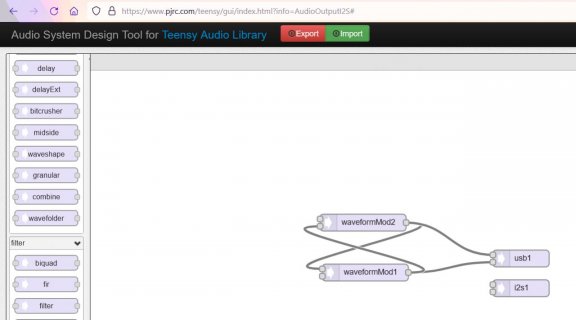Hi there,
I'd like to understand how block processing happens at a high level when the audio "graph" contains loops, as in the case below (waveform2 gets fm from waveform1, waveform1 gets pwm from waveform2). Given that the Audio library processes AUDIO_BLOCK_SAMPLES at a time, I see the following options:
If it's 2. are there some rules I might understand?

I'd like to understand how block processing happens at a high level when the audio "graph" contains loops, as in the case below (waveform2 gets fm from waveform1, waveform1 gets pwm from waveform2). Given that the Audio library processes AUDIO_BLOCK_SAMPLES at a time, I see the following options:
- always use data that lags by AUDIO_BLOCK_SAMPLES (each waveform uses the "cached" result of the previous block processing)
- arbitrarily (or otherwise by some set of rules), break the cycle and process (say) waveform1 then use the result for waveform2
- something else?
If it's 2. are there some rules I might understand?
Code:
#include <Audio.h>
#include <Wire.h>
#include <SPI.h>
#include <SD.h>
#include <SerialFlash.h>
// GUItool: begin automatically generated code
AudioSynthWaveformModulated waveformMod2; //xy=491.20001220703125,327
AudioSynthWaveformModulated waveformMod1; //xy=495.20001220703125,416
AudioOutputUSB usb1; //xy=772.2000122070312,391
AudioOutputI2S i2s1; //xy=772.2000122070312,444
AudioConnection patchCord1(waveformMod2, 0, waveformMod1, 0);
AudioConnection patchCord2(waveformMod2, 0, usb1, 0);
AudioConnection patchCord3(waveformMod1, 0, usb1, 1);
AudioConnection patchCord4(waveformMod1, 0, waveformMod2, 1);
// GUItool: end automatically generated code
// the setup routine runs once when you press reset:
void setup() {
AudioMemory(256);
int masterVolume = 1;
waveformMod1.begin(WAVEFORM_SQUARE);
waveformMod2.begin(WAVEFORM_PULSE);
waveformMod1.offset(1);
waveformMod1.amplitude(masterVolume);
waveformMod2.amplitude(masterVolume);
}
// the loop routine runs over and over again forever:
void loop() {
float knob_1 = 0.2;
float knob_2 = 0.8;
float pitch1 = pow(knob_1, 2);
// float pitch2 = pow(knob_2, 2);
waveformMod1.frequency(10 + (pitch1 * 50));
waveformMod2.frequency(10 + (knob_2 * 200));
waveformMod1.frequencyModulation(knob_2 * 8 + 3);
}

